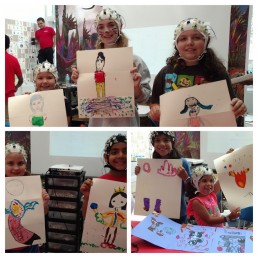



Exquisite Corpse – Visual Arts Children
We used Mobile brain-body imaging (MoBI) technology to study the human improvisational creative process in the spirit of the “Exquisite Corpse”, an improvisational creative game created by the surrealists in the 1920s, three artists create a three-part art piece. The artists were equipped with 64 channel wireless EEG (2 channel EOG) and 3 inertial measurement units on forearms and head.
The experiments were conducted in at the Children Museum of Houston which enabled an engaging and natural environment for them to perform. In this study, children(artists) wore skullcaps fitted with EEG electrodes and inertial sensors as they played Exquisite Corpse. The performance-study seeks to uncover clues to what happens in the brain as they create and contemplate art. Working simultaneously before a live audience, each artist has 15 minutes to begin creating an artwork. After 15 minutes, their work-in-progress is concealed with a cloth, leaving only a small portion exposed. The artists then rotate stations and take turns adding to each other’s creations for two additional 15-minute increments. Their brain activity is projected onto a nearby screen as audience members watch and also contribute their MoBI data.
Acknowledgements
NSF award #BCS1533691
Cullen College of Engineering, University of Houston

